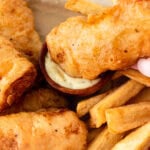Gluten-Free Fish & Chips
Enjoy a fish fry at home with this gluten-free fish and chips recipe. My family loves fish and chips, so creating a gluten-free batter was a no-brainer. Whether you’re gluten-free or just looking for a lighter alternative, this recipe is easy to make and full of flavor.
Servings: 4 servings
Ingredients
Dredge Ingredients
- ¼ cup rice flour
- ½ tsp salt
- ¼ tsp black pepper
Fish Ingredients
- 1 ½ - 2 lbs white fish Haddock or Cod is best, cut into 2-3” strips
- 1 cup GF flour mix
- ¼ cup white rice flour
- 1 tsp baking powder
- 1 tsp salt
- ½ tsp onion powder
- ½ tsp garlic powder
- ½ tsp Old Bay seasoning
- ½ tsp paprika
- ½ tsp black pepper
- 1 egg
- 12 oz of gluten free beer or club soda
Chips
- 3 lbs Russet potatoes washed, peeled and cut into ½”- ¾” sticks
Instructions
- Add 3” cooking oil to a deep pot and heat the oil to 375 degrees F (Once the fish is added, the temperature will dip to about 350F). Use a cooking thermometer to monitor the oil temperature. Place the potatoes into a large pot. Fill with enough water to submerge them and place the pot over medium heat.
- Bring to a boil, then turn off the heat. Leave the potatoes to sit in the hot water for 30 minutes.
- Prepare the dredge for the fish. On a rimmed plate or bowl, whisk together the rice flour, salt and pepper.
- Prepare the batter. Whisk together the gluten free flour blend, white rice flour, baking powder, salt, garlic powder, onion powder, Old Bay, paprika and pepper. Whisk in the egg and gluten free beer. Let the batter sit for 5 minutes.
- While the batter sits, pat the fish dry with paper towels. Coat each filet with the dredge mixture so that all sides are coated with a thin layer of flour.
- Line two baking sheets with paper towels. Dip the dredged fillets into the batter to coat completely. Carefully lower a few dipped fillets at a time into the hot oil. I like to use a spider skimmer to do this, but tongs also work well. Work in small batches to not crowd the pot. Overcrowding can cause the temperature to drop, resulting in soggy, oily fish.
- Fry the fish, turning occasionally for about 5-7 minutes. The batter will be crispy and golden, with an internal temperature of 130°F-135°F. Place the fried fish on a baking sheet lined with paper towels to absorb excess oil before transferring to a wire rack. Sprinkle with salt. Bring the oil back up to temperature before frying the next batch.
- Remove the potatoes from the warm water and pat dry with paper towels. Lower the oil temperature to 300°F.
- Par-fry the chips, in batches, to not overcrowd the pan, for about 3-5 minutes. The goal here is to cook the interior, not to fry the exterior to golden. Par-frying cooks the chips so that they’re fluffy and pillowy on the inside. Place the chips on paper towels to soak up any extra oil.
- Increase the oil temperature to 375°F. Fry the chips again, in batches, to not over crowd the pan, for 1-3 minutes until golden brown and crispy. Transfer to paper towels and sprinkle with salt. Serve the chips with the fish, along with tartar sauce and lemon wedges.
Notes
- My number one tip for deep frying is consistency with the size. Cut the fish and potatoes evenly to ensure an even cook.
- Remove any skin from the fish that acts as an insulator, and be sure to pat the fish dry before dredging to help the batter stick.
- You can use any white fish like haddock, cod, or seabass.
- The carbonation from the beer keeps the batter light and airy. I prefer using gluten-free beer because it adds a depth of flavor to the batter. If you can’t find it, use club soda.
- Use your oven on a low temp of 200°F to keep the fish warm while you work in batches.
- Don’t skip the parboil and par-frying of the potatoes. This softens the inside while preparing the outside to crisp.
- Test the oil by adding a small piece of fish or batter to the pot. If the oil bubbles vigorously around the piece and floats to the surface within a few seconds, the oil is ready for frying.
- Maintain the right temperature of the oil by using a thermometer, as temperature fluctuations can lead to greasy food.
- I recommend eating the fish & chips the same day for peak freshness. If you have leftovers, store the fish and chips separately in airtight containers in the refrigerator for up to 2 days.
Nutrition
Serving: 1serving | Calories: 663kcal | Carbohydrates: 104g | Protein: 48g | Fat: 6g | Saturated Fat: 2g | Polyunsaturated Fat: 1g | Monounsaturated Fat: 2g | Trans Fat: 0.01g | Cholesterol: 126mg | Sodium: 1103mg | Potassium: 2005mg | Fiber: 8g | Sugar: 3g | Vitamin A: 195IU | Vitamin C: 19mg | Calcium: 158mg | Iron: 6mg
